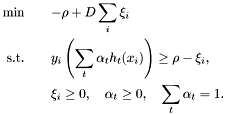
#include <lpboost.h>
Inheritance diagram for LPBoost:


Public Member Functions | |
| LPBoost () | |
| LPBoost (const Boosting &s) | |
| LPBoost (std::istream &is) | |
| virtual const id_t & | id () const |
| virtual LPBoost * | create () const |
| Create a new object using the default constructor. | |
| virtual LPBoost * | clone () const |
| Create a new object by replicating itself. | |
| virtual bool | set_aggregation_size (UINT) |
| virtual void | train () |
| Train with preset data set and sample weight. | |
| REAL | C () const |
| The regularization constant C. | |
| void | set_C (REAL _C) |
| Set the regularization constant C. | |
With a similar idea to the original LPBoost [1], which solves

we instead implement the algorithm to solve

by column generation. Note that the dual problem is

Column generation corresponds to generating the constraints (*). We actually use individual upper bound  proportional to example's initial weight.
proportional to example's initial weight.
If we treat  , the normalized version of
, the normalized version of  , as the sample weight, and
, as the sample weight, and  as the normalization constraint, (*) is the same as
as the normalization constraint, (*) is the same as
![\[ \Sigma_u (1 - 2 e(h_t, w)) \le 1, \]](form_32.png)
which means
![\[ e(h_t, w) \ge \frac12 (1 - \Sigma_u^{-1}).\qquad (**) \]](form_33.png)
Assume that we have found  so far, solving the dual problem with
so far, solving the dual problem with  (*) constraints gives us
(*) constraints gives us  . If for every remaining
. If for every remaining  in
in  ,
,  the duality condition tells us that even if we set
the duality condition tells us that even if we set  for those remaining
for those remaining  , the solution is still optimal. Thus, we can train the weak learner with sample weight
, the solution is still optimal. Thus, we can train the weak learner with sample weight  in each iteration, and terminate if the best hypothesis has satisfied (**).
in each iteration, and terminate if the best hypothesis has satisfied (**).
[1] A. Demiriz, K. P. Bennett, and J. Shawe-Taylor. Linear programming boosting via column generation. Machine Learning, 46(1-3):225-254, 2002.
Definition at line 59 of file lpboost.h.
|
|
Definition at line 63 of file lpboost.h. References LPBoost::set_C(). Referenced by LPBoost::clone(), and LPBoost::create(). |
|
|
Definition at line 64 of file lpboost.h. References Boosting::convex, and LPBoost::set_C(). |
|
|
|
|
|
The regularization constant C.
|
|
|
Create a new object by replicating itself.
return new Derived(*this);
Reimplemented from Boosting. Definition at line 69 of file lpboost.h. References LPBoost::LPBoost(). |
|
|
Create a new object using the default constructor. The code for a derived class Derived is always return new Derived(); Reimplemented from Boosting. Definition at line 68 of file lpboost.h. References LPBoost::LPBoost(). |
|
|
Reimplemented from Boosting. |
|
|
Reimplemented from Aggregating. |
|
|
Set the regularization constant C.
Definition at line 78 of file lpboost.h. Referenced by LPBoost::LPBoost(). |
|
|
Train with preset data set and sample weight.
Reimplemented from Boosting. Definition at line 66 of file lpboost.cpp. References Boosting::grad_desc_view, Aggregating::lm_base, LearnModel::n_samples, LearnModel::ptd, LearnModel::ptw, LearnModel::set_dimensions(), and U. |
 1.4.6
1.4.6